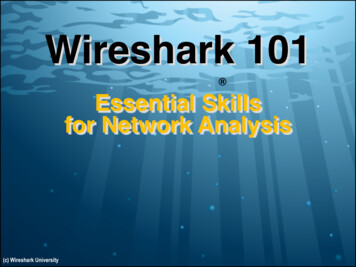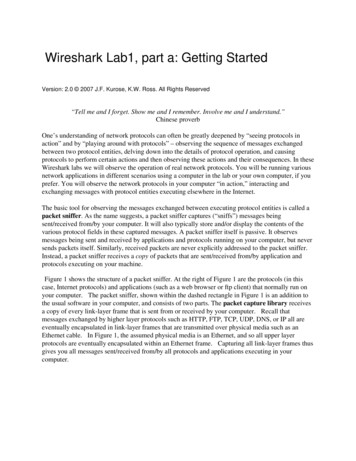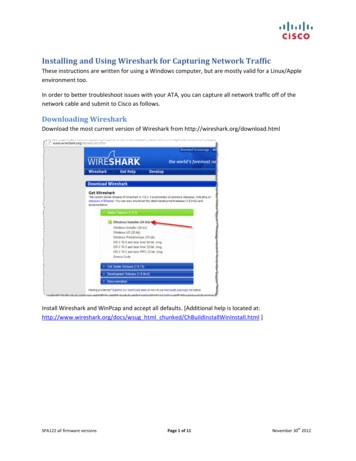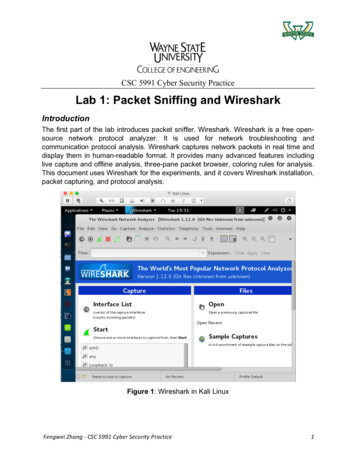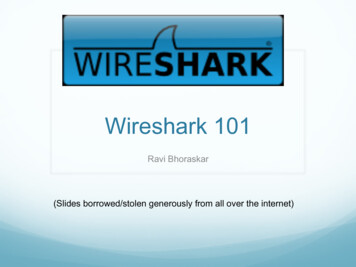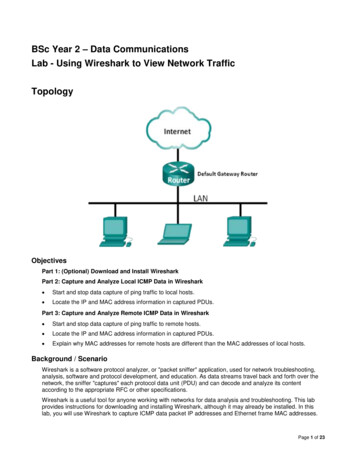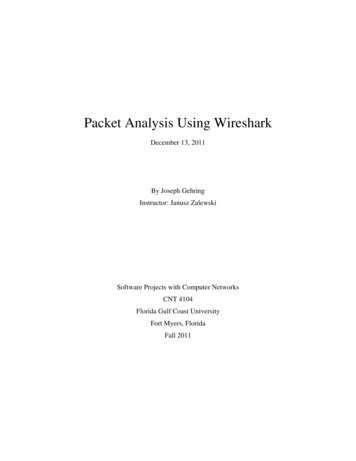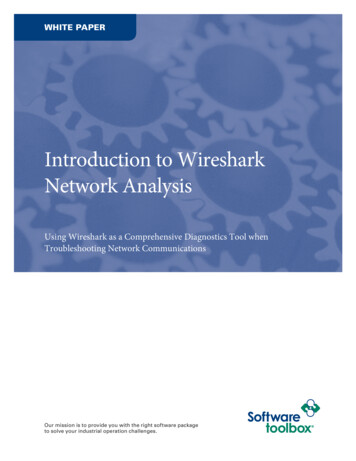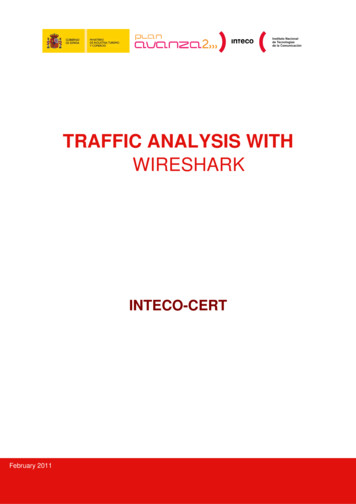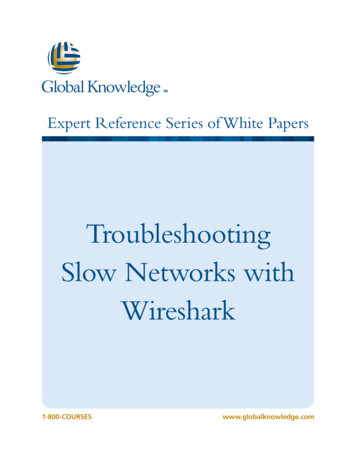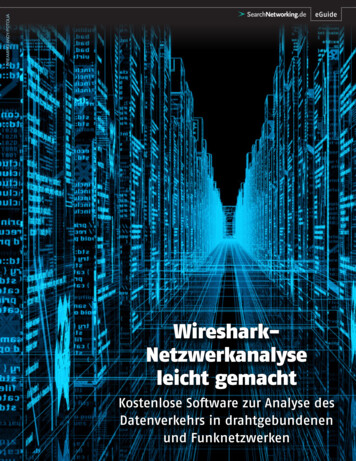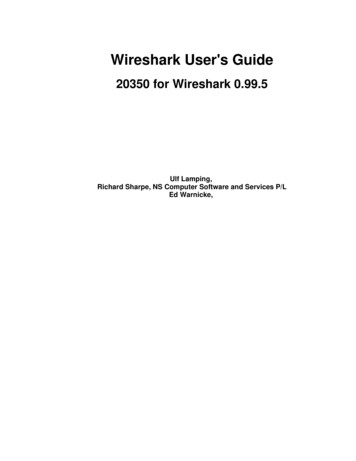
Transcription
Wireshark User's Guide20350 for Wireshark 0.99.5Ulf Lamping,Richard Sharpe, NS Computer Software and Services P/LEd Warnicke,
Wireshark User's Guide: 20350for Wireshark 0.99.5by Ulf Lamping, Richard Sharpe, and Ed WarnickeCopyright 2004-2007 Ulf Lamping Richard Sharpe Ed WarnickePermission is granted to copy, distribute and/or modify this document under the terms of the GNU General Public License, Version 2 or any later version published by the Free Software Foundation.All logos and trademarks in this document are property of their respective owner.
Table of ContentsPreface . viii1. Foreword . viii2. Who should read this document? . ix3. Acknowledgements . x4. About this document . xi5. Where to get the latest copy of this document? . xii6. Providing feedback about this document . xiii1. Introduction . 11.1. What is Wireshark? . 11.1.1. Some intended purposes . 11.1.2. Features . 11.1.3. Live capture from many different network media . 21.1.4. Import files from many other capture programs . 21.1.5. Export files for many other capture programs . 21.1.6. Many protocol decoders . 31.1.7. Open Source Software . 31.1.8. What Wireshark is not . 31.2. System Requirements . 41.2.1. General Remarks . 41.2.2. Microsoft Windows . 41.2.3. Unix / Linux . 51.3. Where to get Wireshark? . 61.4. A brief history of Wireshark . 71.5. Development and maintenance of Wireshark . 81.6. Reporting problems and getting help . 91.6.1. Website . 91.6.2. Wiki . 91.6.3. FAQ . 91.6.4. Mailing Lists . 91.6.5. Reporting Problems . 101.6.6. Reporting Crashes on UNIX/Linux platforms . 101.6.7. Reporting Crashes on Windows platforms . 112. Building and Installing Wireshark . 132.1. Introduction . 132.2. Obtaining the source and binary distributions . 142.3. Before you build Wireshark under UNIX . 152.4. Building Wireshark from source under UNIX . 182.5. Installing the binaries under UNIX . 202.5.1. Installing from rpm's under RedHat and alike . 202.5.2. Installing from deb's under Debian . 202.5.3. Installing from portage under Gentoo Linux . 202.5.4. Installing from packages under FreeBSD . 202.6. Troubleshooting during the install on Unix . 212.7. Building from source under Windows . 222.8. Installing Wireshark under Windows . 232.8.1. Install Wireshark . 232.8.2. Install WinPcap . 252.8.3. Update Wireshark . 252.8.4. Update WinPcap . 252.8.5. Uninstall Wireshark . 262.8.6. Uninstall WinPcap . 263. User Interface . 283.1. Introduction . 28iv
Wireshark User's Guide3.2. Start Wireshark . 293.3. The Main window . 303.3.1. Main Window Navigation . 313.4. The Menu . 323.5. The "File" menu . 343.6. The "Edit" menu . 373.7. The "View" menu . 393.8. The "Go" menu . 433.9. The "Capture" menu . 453.10. The "Analyze" menu . 473.11. The "Statistics" menu . 493.12. The "Help" menu . 523.13. The "Main" toolbar . 543.14. The "Filter" toolbar . 573.15. The "Packet List" pane . 593.16. The "Packet Details" pane . 603.17. The "Packet Bytes" pane . 613.18. The Statusbar . 624. Capturing Live Network Data . 644.1. Introduction . 644.2. Prerequisites . 654.3. Start Capturing . 664.4. The "Capture Interfaces" dialog box . 674.5. The "Capture Options" dialog box . 694.5.1. Capture frame . 704.5.2. Capture File(s) frame . 714.5.3. Stop Capture. frame . 714.5.4. Display Options frame . 724.5.5. Name Resolution frame . 724.5.6. Buttons . 724.6. Capture files and file modes . 734.7. Link-layer header type . 754.8. Filtering while capturing . 764.8.1. Automatic Remote Traffic Filtering . 774.9. While a Capture is running . . 794.9.1. Stop the running capture . 794.9.2. Restart a running capture . 805. File Input / Output and Printing . 825.1. Introduction . 825.2. Open capture files . 835.2.1. The "Open Capture File" dialog box . 835.2.2. Input File Formats . 855.3. Saving captured packets . 875.3.1. The "Save Capture File As" dialog box . 875.3.2. Output File Formats . 895.4. Merging capture files . 915.4.1. The "Merge with Capture File" dialog box . 915.5. File Sets . 935.5.1. The "List Files" dialog box . 935.6. Exporting data . 955.6.1. The "Export as Plain Text File" dialog box . 955.6.2. The "Export as PostScript File" dialog box . 965.6.3. The "Export as CSV (Comma Separated Values) File" dialog box . 965.6.4. The "Export as PSML File" dialog box . 975.6.5. The "Export as PDML File" dialog box . 975.6.6. The "Export selected packet bytes" dialog box . 985.7. Printing packets . 1005.7.1. The "Print" dialog box . 100v
Wireshark User's Guide5.8. The Packet Range frame .5.9. The Packet Format frame .6. Working with captured packets .6.1. Viewing packets you have captured .6.2. Pop-up menus .6.2.1. Pop-up menu of the "Packet List" pane .6.2.2. Pop-up menu of the "Packet Details" pane .6.2.3. Pop-up menu of the "Packet Bytes" pane .6.3. Filtering packets while viewing .6.4. Building display filter expressions .6.4.1. Display filter fields .6.4.2. Comparing values .6.4.3. Combining expressions .6.4.4. A common mistake .6.5. The "Filter Expression" dialog box .6.6. Defining and saving filters .6.7. Finding packets .6.7.1. The "Find Packet" dialog box .6.7.2. The "Find Next" command .6.7.3. The "Find Previous" command .6.8. Go to a specific packet .6.8.1. The "Go Back" command .6.8.2. The "Go Forward" command .6.8.3. The "Go to Packet" dialog box .6.8.4. The "Go to Corresponding Packet" command .6.8.5. The "Go to First Packet" command .6.8.6. The "Go to Last Packet" command .6.9. Marking packets .6.10. Time display formats and time references .6.10.1. Packet time referencing .7. Advanced Topics .7.1. Introduction .7.2. Following TCP streams .7.2.1. The "Follow TCP Stream" dialog box .7.3. Time Stamps .7.3.1. Wireshark internals .7.3.2. Capture file formats .7.3.3. Accuracy .7.4. Time Zones .7.4.1. Set your computer's time correct! .7.4.2. Wireshark and Time Zones .7.5. Packet Reassembling .7.5.1. What is it? .7.5.2. How Wireshark handles it .7.6. Name Resolution .7.6.1. Name Resolution drawbacks .7.6.2. Ethernet name resolution (MAC layer) .7.6.3. IP name resolution (network layer) .7.6.4. IPX name resolution (network layer) .7.6.5. TCP/UDP port name resolution (transport layer) .7.7. Checksums .7.7.1. Wireshark checksum validation .7.7.2. Checksum offloading .8. Statistics .8.1. Introduction .8.2. The "Summary" window .8.3. The "Protocol Hierarchy" window .8.4. Endpoints 141142142143145145146149151
Wireshark User's Guide8.4.1. What is an Endpoint? .8.4.2. The "Endpoints" window .8.4.3. The protocol specific "Endpoint List" windows .8.5. Conversations .8.5.1. What is a Conversation? .8.5.2. The "Conversations" window .8.5.3. The protocol specific "Conversation List" windows .8.6. The "IO Graphs" window .8.7. Service Response Time .8.7.1. The "Service Response Time DCE-RPC" window .8.8. The protocol specific statistics windows .9. Customizing Wireshark .9.1. Introduction .9.2. Start Wireshark from the command line .9.3. Packet colorization .9.4. Control Protocol dissection .9.4.1. The "Enabled Protocols" dialog box .9.4.2. User Specified Decodes .9.4.3. Show User Specified Decodes .9.5. Preferences .A. Files and Folders .A.1. Capture Files .A.1.1. Libpcap File Contents .A.1.2. Not Saved in the Capture File .A.2. Configuration Files and Folders .A.3. Windows folders .A.3.1. Windows profiles .A.3.2. Windows NT/2000/XP roaming profiles .A.3.3. Windows temporary folder .B. Protocols and Protocol Fields .C. Wireshark Messages .C.1. Packet List Messages .C.1.1. [Malformed Packet] .C.1.2. [Packet size limited during capture] .C.2. Packet Details Messages .C.2.1. [Response in frame: 123] .C.2.2. [Request in frame: 123] .C.2.3. [Time from request: 0.123 seconds] .D. Related command line tools .D.1. Introduction .D.2. tshark: Terminal-based Wireshark .D.3. tcpdump: Capturing with tcpdump for viewing with Wireshark .D.4. dumpcap: Capturing with dumpcap for viewing with Wireshark .D.5. capinfos: Print information about capture files .D.6. editcap: Edit capture files .D.7. mergecap: Merging multiple capture files into one .D.8. text2pcap: Converting ASCII hexdumps to network captures .D.9. idl2wrs: Creating dissectors from CORBA IDL files .D.9.1. What is it? .D.9.2. Why do this? .D.9.3. How to use idl2wrs .D.9.4. TODO .D.9.5. Limitations .D.9.6. Notes .E. This Document's License (GPL) 7207207209209209211
Preface1. ForewordWireshark is one of those programs that many network managers would love to be able to use, but theyare often prevented from getting what they would like from Wireshark because of the lack of documentation.This document is part of an effort by the Wireshark team to improve the usability of Wireshark.We hope that you find it useful, and look forward to your comments.viii
Preface2. Who should read this document?The intended audience of this book is anyone using Wireshark.This book will explain all the basics and also some of the advanced features that Wireshark provides. AsWireshark has become a very complex program since the early days, not every feature of Wiresharkmight be explained in this book.This book is not intended to explain network sniffing in general and it will not provide details about specific network protocols. A lot of useful information regarding these topics can be found at the WiresharkWiki at http://wiki.wireshark.orgBy reading this book, you will learn how to install Wireshark, how to use the basic elements of thegraphical user interface (like the menu) and what's behind some of the advanced features that are maybenot that obvious at first sight. It will hopefully guide you around some common problems that frequentlyappears for new (and sometimes even advanced) users of Wireshark.ix
Preface3. AcknowledgementsThe authors would like to thank the whole Wireshark team for their assistance. In particular, the authorswould like to thank: Gerald Combs, for initiating the Wireshark project and funding to do this documentation. Guy Harris, for many helpful hints and a great deal of patience in reviewing this document. Gilbert Ramirez, for general encouragement and helpful hints along the way.The authors would also like to thank the following people for their helpful feedback on this document: Pat Eyler, for his suggestions on improving the example on generating a backtrace. Martin Regner, for his various suggestions and corrections. Graeme Hewson, for a lot of grammatical corrections.The authors would like to acknowledge those man page and README authors for the Wireshark projectfrom who sections of this document borrow heavily: Scott Renfro from whose mergecap man page Section D.7, “mergecap: Merging multiple capturefiles into one ” is derived. Ashok Narayanan from whose text2pcap man page Section D.8, “text2pcap: Converting ASCIIhexdumps to network captures ” is derived. Frank Singleton from whose README.idl2wrs Section D.9, “idl2wrs: Creating dissectors fromCORBA IDL files ” is derived.x
Preface4. About this documentThis book was originally developed by Richard Sharpe with funds provided from the Wireshark Fund. Itwas updated by Ed Warnicke and more recently redesigned and updated by Ulf Lamping.It is written in DocBook/XML.You will find some specially marked parts in this book:This is a warning!You should pay attention to a warning, as otherwise data loss might occur.This is a note!A note will point you to common mistakes and things that might not be obvious.This is a tip!Tips will be helpful for your everyday work using Wireshark.xi
Preface5. Where to get the latest copy of thisdocument?The latest copy of this documentation can always be found at: http:/ / www.wireshark.org/ docs/#usersguide.xii
Preface6. Providing feedback about this documentShould you have any feedback about this document, please send them to the authors through wiresharkdev[AT]wireshark.org.xiii
Prefacexiv
Chapter 1. Introduction1.1. What is Wireshark?Wireshark is a network packet analyzer. A network packet analyzer will try to capture network packetsand tries to display that packet data as detailed as possible.You could think of a network packet analyzer as a measuring device used to examine what's going oninside a network cable, just like a voltmeter is used by an electrician to examine what's going on insidean electric cable (but at a higher level, of course).In the past, such tools were either very expensive, proprietary, or both. However, with the advent ofWireshark, all that has changed.Wireshark is perhaps one of the best open source packet analyzers available today.1.1.1. Some intended purposesHere are some examples people use Wireshark for: network administrators use it to troubleshoot network problems network security engineers use it to examine security problems developers use it to debug protocol implementations people use it to learn network protocol internalsBeside these examples, Wireshark can be helpful in many other situations too.1.1.2. FeaturesThe following are some of the many features Wireshark provides: Available for UNIX and Windows. Capture live packet data from a network interface. Display packets with very detailed protocol information. Open and Save packet data captured. Import and Export packet data from and to a lot of other capture programs. Filter packets on many criteria. Search for packets on many criteria. Colorize packet display based on filters. Create various statistics. . and a lot more!1
IntroductionHowever, to really appreciate its power, you have to start using it.Figure 1.1, “ Wireshark captures packets and allows you to examine their content. ” shows Wiresharkhaving captured some packets and waiting for you to examine them.Figure 1.1. Wireshark captures packets and allows you to examine their content.1.1.3. Live capture from many different network mediaWireshark can capture traffic from many different network media types - and despite it's name includingwireless LAN as well. Which media types are supported, depends on many things like the operating system you are using. An overview of t
Wireshark is one of those programs that many network managers would love to be able to use, but they are often prevented from getting what they would like from Wireshark because of the lack of document-ation. This document is part of an effort by the Wireshark tea
